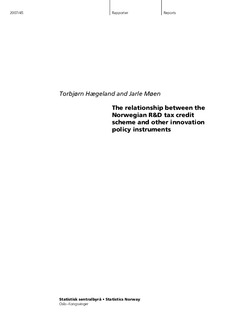| dc.description.abstract | We first study how participation in the Norwegian R&D tax credit scheme affects the probability of receiving other
R&D and innovation subsidies. We find no evidence suggesting that using the R&D tax credit increase the probability
of receiving direct R&D subsidies in the future, but we cannot exclude the possibility of an immediate positive effect.
At the individual firm level, direct subsidies and the tax credit seem to be complements, while at the innovation
system level they seem to be substitutes, as the probability of receiving direct subsidies has fallen after the
introduction of the tax credit scheme.
Next, we compare the additionality of the R&D tax credit with direct R&D subsidies. Our preferred estimate suggests
that each public krone spent on tax credits for firms investing below the 4 million cap on intramural R&D increases
private intramural R&D by 2.68 kroner. This estimate builds on an assumption of zero additionality for firms above
the 4 million cap. We find that the additionality of subsidies awarded through the Research Council and Innovation
Norway is 2.07 and 1.53 respectively. The additionality of grants awarded by ministries and other public agencies is
0.64, and the additionality of R&D subsidies from the EU is 0.75. We stress the potential for both positive and
negative biases in these estimates.
Direct R&D subsidies are intended for projects with low private return and high social return. We find that projects
funded through direct grants have essentially zero returns. Although surprisingly low, this is consistent with a high
quality grant allocation process. Our estimate for the return to R&D projects financed by tax credits is just slightly
below the return to R&D projects financed by own funds. This is to be expected as this type of R&D has a lower
marginal price. The estimated returns are 16 % and 19 % respectively. All estimates are likely to be downward
biased by measurement errors in the R&D variables. Furthermore, there is large variance in the returns to R&DOrdninger og tiltak innføres sjelden eller aldri i et
vakuum. De kommer gjerne i tillegg til eller i stedet for
eksisterende ordninger, og implementeres i en virkelighet
hvor andre lover, regelverk og andre generelle
virkemidler også påvirker aktørenes tilpasning til og
eventuelle effekter av den nye ordningen. Innføringen
av SkatteFUNN-ordningen er ikke noe unntak fra dette.
I denne rapportent studerer vi hvordan SkatteFUNNordningen
virker i samspill med andre virkemidler for
FoU, med spesiell vekt på hvorvidt innføringen av
SkatteFUNN har påvirket sannsynligheten for å få
tilgang til eller benytte seg av andre deler av
virkemiddelapparatet. I tillegg har vi sett på forskjeller
i innsatsaddisjonalitet og avkastning mellom ulike
typer virkemidler.
projects. When estimating the return parameters year by year, they vary considerably around their overall mean. __ | no_NO |
